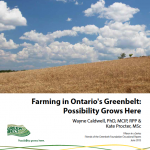Farming in Ontario’s Greenbelt: Possibility Grows Here
Posted: October 22, 2013
Categories: GoodFoodBites / News from Sustain Members
Farming in Ontario’s Greenbelt: Possibility Grows Here is the fifteenth in a series of occasional papers by the Friends of the Greenbelt Foundation exploring key issues related to strengthening farm viability and increasing access to market for farmers in Ontario’s Greenbelt. The report was prepared by Professor Wayne Caldwell of the University of Guelph and aims to provide recommendations to ensure the continued viability of farming across the Greenbelt.
Research for the paper was conducted through consultations and interviews with various famers as well as planners, municipal and provincial officials, and conservation authority staff. Farmers expressed general frustration with multiple layers of regulation, inconsistencies in interpreting regulations across municipalities, inconsistent objectives across provincial ministries, a lack of understanding and appreciation of agriculture among planners, and costs associated with meeting regulations.
Chapter six of the report outlines a series of recommendations for addressing the concerns of farmers, including ensuring clarity and coordination among different levels of regulations and fostering greater dialogue and understanding between urban planners and the farm community, based on the following eight key principles:
- Provide coordination and clarity.
- Increased consistency in provincial and municipal policies should be encouraged
- Reconfirm the socio-economic importance of agriculture.
- Agricultural knowledge can help diffuse issues, build understanding, and facilitate
- good planning.
- The cost of regulation on agriculture and related approval times needs to be
- reasonable and manageable.
- Standards and mapping of natural heritage features need to be clear, defensible,
- and open to public scrutiny.
- Agricultural and environmental goals are priorities and should be mutually supportive.
- Prosperous farms are desirable, they contribute to community well-being, and they are the best way to build support for agricultural land preservation.
Ontario’s Greenbelt Plan (GBP) was established in 2005 and permanently protects more than 1.8 million acres of farmland and environmentally sensitive land in the Greater Golden Horseshoe from urban development. Agriculture in the Greenbelt is incredibly diverse, comprised of a range of farmers producing corn, soybeans, fruits, and vegetable as well as speciality products. In addition, Greenbelt farming also boasts a range of livestock production including beef, dairy, poultry, and hogs.
The report concludes that farmers in the region face challenges that are complex and multilayered and require, “a determined, consistent, and long-term commitment to doing the right things – the things that will build capacity within the farm sector, make farms profitable, and increase their value from an economic, environmental, and social perspective (p.39).”

